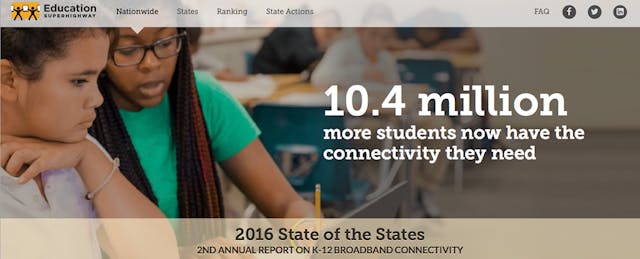For anyone taking on a project, EducationSuperHighway CEO Evan Marwell has a few words of advice:
“If you want to accomplish any goal, you have to measure progress,” he says. ”You can't manage what you can't measure.”
The mantra makes sense for someone like Marwell, whose nonprofit organization has an audacious mission: to make high-speed internet access available for every student in the US. But in order to do that, EducationSuperHighway must first determine the state of internet access—and track its progress—for schools across the country.
The San Francisco-based nonprofit’s most recent report, 2016 State of the States, is one part of that process. And it has some big numbers to share, starting with 34.9 million of US students who are now meeting the Federal Communications Commission’s (FCC) minimum internet access goal of 100 kbps per student. That’s 10.4 million more students than in last year’s report, and a staggering 30.9 million more compared to 2013.

EducationSuperHighway
To gather its findings, EducationSuperHighway turned to E-Rate, an FCC program that provides funding to help schools and libraries build fiber infrastructure and expand their wi-fi and broadband networks. The program offers a wealth of school internet data which EducationSuperHighway used for its first State of the States report, based on 6,500 reporting districts, in 2015. The newest edition has more robust data from nearly 10,500 public school districts, or roughly 80 percent of the total in the U.S.
With more E-Rate data comes a more detailed picture for the state of internet connectivity. In addition to the 34.9 million students now connected, the report shows that now 95 percent of schools have fiber optic connections they need to meet the FCC minimum goal of 100 kbps per student. That’s a huge win, Marwell says, given that lack of fiber was a main roadblock to connectivity in 2015.
As more fiber networks have been established—largely due to subsidies provided by E-Rate and work by state leaders—more schools have also been able to get the wi-fi they need. According to the report, 83 percent of schools now have adequate wi-fi in place to support 1:1 learning environments. “That’s incredible progress when you look at how only 25 percent of schools could make that statement” in 2013, says Marwell.
The report also found that 42 percent of districts have also upgraded their existing broadband at little or no extra cost. On average, those who did tripled their bandwidth while only paying 7 percent more than before—and 39 percent of districts that upgraded did so while lowering or maintaining their monthly internet fees.
Marwell attributes these improvements to better pricing transparency that helps districts see what others are paying and leverage that knowledge to get more bang for buck from their service provider. In November, EducationSuperHighway released Compare & Connect K-12, a free tool that maps E-Rate data to make those comparisons available for administrators, state leaders and service providers.
“This is all about measuring where we stand and the progress we are making,” he says, “and to give state and district leaders the information they need to be able to take action.”
Students Are Still Left Behind
Although the connectivity numbers are trending in the right direction, that still leaves 11.6 million students without the minimum bandwidth to access digital learning tools. Roughly 3,700 schools still lack fiber-optic connections and 15,000 schools struggle with insufficient wi-fi.

EducationSuperHighway
Next Steps
One way to ensure that high-speed access reaches these students and schools is to continue making major improvements to their fiber networks. Perhaps even more crucial now, Marwell says, is also making broadband more affordable. According to the report, only half of all school districts today are meeting affordability targets set by national benchmark prices.
One of the most startling findings from the 2016 report is that districts that pay most for broadband also tend to be those that receive the slowest service. Specifically, districts not meeting the 100 kbps per student goal pay on average $7.81 per Mbps, while costs for those meeting future FCC goal of 1 Mbps per student averages to just $1.33.
“There is an unquestioned correlation between how much you pay for broadband and whether or not you can afford to buy enough to meet connectivity goals,” explains Marwell. “The amount of bandwidth [districts] can get for their budget really is what’s determining if they can give their students and teacher the access that they need.”
Laying the infrastructure to lower broadband costs will take work continued effort from state leaders, administrators and service providers. In 2015, 40 governors committed to upgrading their schools’ connectivity. At least 34 of those governors took action, and now 16 states have established or proposed taking advantage of E-Rate with matching funds to help ease the burden of the one-time cost of fiber construction, which ranges from $75,000 to over $420,000 per school.
“If you look at the 11.6 million students that still need to be upgraded, almost 7.5 million can get to the bandwidth they need simply by getting their districts affordable broadband,” estimates Marwell.
Going forward, continued work with state leaders is at at the top of EducationSuperHighway’s agenda in its mission to close America’s connectivity gap. “Those were not idle promises and governors are taking a lot of action to get this done,” says Marwell. “We have seen amazing progress when governors get involved.”
EducationSuperHighway will also continue analyzing E-Rate data to measure progress and track which districts need the most support. And, newly added to its list of action items, the organization will be dipping its toes into more direct work with service providers.
“There will be a new effort by us working with top service providers to see what can we do to help them launch a program to get more students with broadband,” Marwell says. “There’s still work to do, but we are getting closer.”


